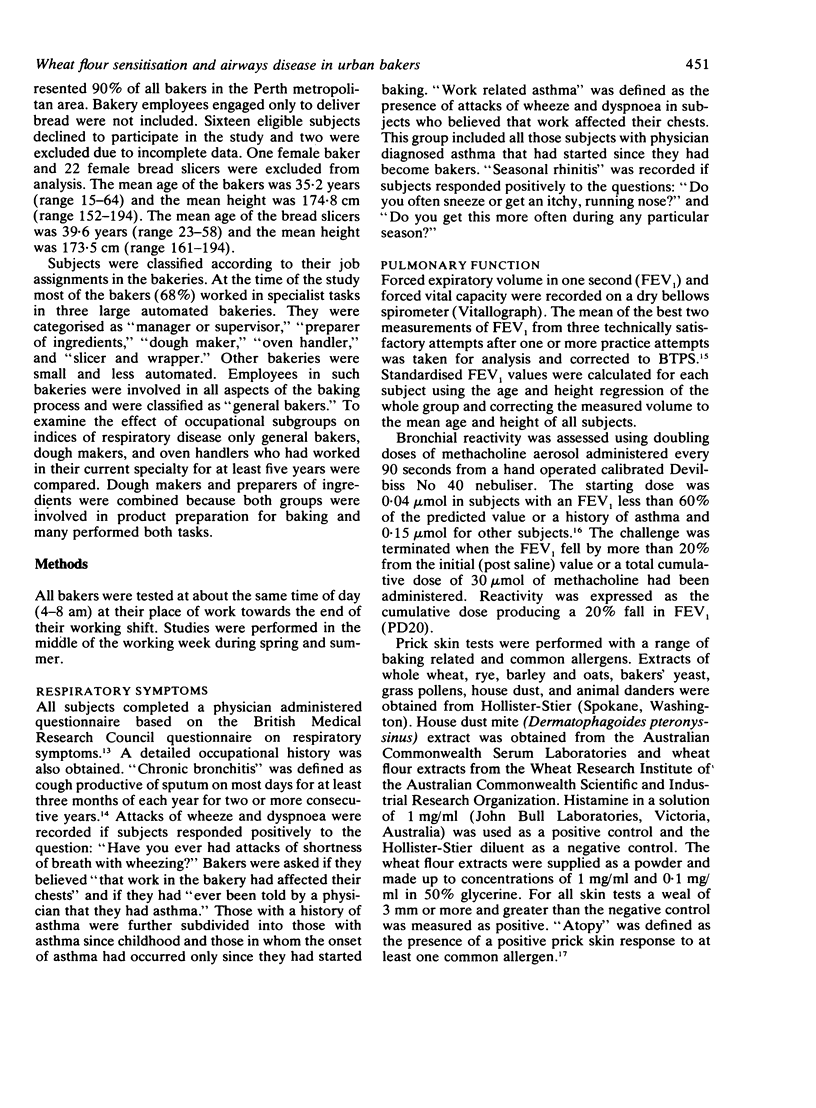Abstract
A total of 176 bakers and 24 subjects employed as bread slicers and wrappers were studied to examine the effect of occupational category on respiratory symptoms, ventilatory capacity, non-specific bronchial reactivity, and prick skin test responses to wheat and common allergens. Bakers had a greater prevalence of attacks of wheeze and dyspnoea and more frequently considered that work affected their chests than did slicers and wrappers. Bakers with a history of asthma with onset since starting work in a bakery had a greater prevalence of chronic cough and sputum, increased bronchial reactivity, and positive prick skin test responses to wheat and common allergens than other bakers. There was a significant association between the frequency of positive prick skin tests to wheat and common allergens, suggesting that prior atopy facilitates sensitisation to cereal antigens. The frequency of positive prick skin responses to common allergens, however, declined with increasing baking duration whereas the frequency of positive skin responses to wheat increased with increasing baking duration, suggesting that subjects who were sensitised to common allergens were leaving the industry whereas subjects who stayed in the industry increased their risk of developing sensitisation to wheat. Oven handlers had a greater prevalence of attacks of wheeze and dyspnoea and more frequently considered that work affected their chests than either dough makers or general bakers. They also had a greater prevalence of positive prick skin test responses to wheat than dough makers or general bakers. Oven handlers also had a lower mean standardised casual FEV1 than either general bakers or dough makers. Thus oven handlers appear to have a greater risk of developing respiratory allergy and airflow obstruction than bakers in other occupational categories.
Full text
PDF




Selected References
These references are in PubMed. This may not be the complete list of references from this article.
- Blands J., Diamant B., Kallós P., Kallós-Deffner L., Lowenstein H. Flour allergy in bakers. I. Identification of allergenic fractions in flour and comparison of diagnostic methods. Int Arch Allergy Appl Immunol. 1976;52(1-4):392–406. [PubMed] [Google Scholar]
- Chan-Yeung M., Wong R., MacLean L. Respiratory abnormalities among grain elevator workers. Chest. 1979 Apr;75(4):461–467. doi: 10.1378/chest.75.4.461. [DOI] [PubMed] [Google Scholar]
- FRANKLAND A. W., LUNN J. A. ASTHMA CAUSED BY THE GRAIN WEEVIL. Br J Ind Med. 1965 Apr;22:157–159. doi: 10.1136/oem.22.2.157. [DOI] [PMC free article] [PubMed] [Google Scholar]
- Hendrick D. J., Davies R. J., Pepys J. Bakers' asthma. Clin Allergy. 1976 May;6(3):241–250. doi: 10.1111/j.1365-2222.1976.tb01903.x. [DOI] [PubMed] [Google Scholar]
- Herxheimer H. The skin sensitivity to flour of baker's apprentices. A final report of a long term investigation. Acta Allergol. 1973 May;28(1):42–49. [PubMed] [Google Scholar]
- Järvinen K. A., Pirilä V., Björksten F., Keskinen H., Lehtinen M., Stubb S. Unsuitability of bakery work for a person with atopy: a study of 234 bakery workers. Ann Allergy. 1979 Mar;42(3):192–195. [PubMed] [Google Scholar]
- Klaustermeyer W. B., Bardana E. J., Jr, Hale F. C. Pulmonary hypersensitivity to Alternaria and Aspergillus in baker's asthma. Clin Allergy. 1977 May;7(3):227–233. doi: 10.1111/j.1365-2222.1977.tb01447.x. [DOI] [PubMed] [Google Scholar]
- Knudson R. J., Slatin R. C., Lebowitz M. D., Burrows B. The maximal expiratory flow-volume curve. Normal standards, variability, and effects of age. Am Rev Respir Dis. 1976 May;113(5):587–600. doi: 10.1164/arrd.1976.113.5.587. [DOI] [PubMed] [Google Scholar]
- Mink J. T., Gerrard J. W., Cockcroft D. W., Cotton D. J., Dosman J. A. Increased bronchial reactivity to inhaled histamine in nonsmoking grain workers with normal lung function. Chest. 1980 Jan;77(1):28–31. doi: 10.1378/chest.77.1.28. [DOI] [PubMed] [Google Scholar]
- Napolitano J., Weiss N. S. Occupational asthma of bakers. Ann Allergy. 1978 Apr;40(4):258–261. [PubMed] [Google Scholar]
- Popa V., George S. A., Găvănescu O. Occupational and non occupational respiratory allergy in bakers. Acta Allergol. 1970 Jun;25(2):159–177. doi: 10.1111/j.1398-9995.1970.tb01389.x. [DOI] [PubMed] [Google Scholar]
- Popescu I. G., Ulmeanu V., Murariu D. Atopic and non-atopic sensitivity in a large bakery. Allergol Immunopathol (Madr) 1981 Jul-Aug;9(4):307–312. [PubMed] [Google Scholar]
- Schraufnagel D., Peloquin A., Paré J. A., Wang N. S. Differentiating bronchioloalveolar carcinoma from adenocarcinoma. Am Rev Respir Dis. 1982 Jan;125(1):74–79. doi: 10.1164/arrd.1982.125.1.74. [DOI] [PubMed] [Google Scholar]
- Thiel H., Ulmer W. T. Bakers' asthma: development and possibility for treatment. Chest. 1980 Aug;78(2 Suppl):400–405. doi: 10.1378/chest.78.2_supplement.400. [DOI] [PubMed] [Google Scholar]
- Woolcock A. J., Colman M. H., Jones M. W. Atopy and bronchial reactivity in Australian and Melanesian populations. Clin Allergy. 1978 Mar;8(2):155–164. doi: 10.1111/j.1365-2222.1978.tb00460.x. [DOI] [PubMed] [Google Scholar]


